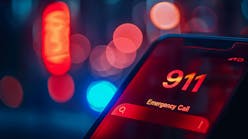In our second installment of this series on Night Vision Goggles (NVG), three fire departments that operate aircraft while using NVG weigh in on the benefits and dangers of night operations.
Los Angeles County Fire Department
The agency that has been using NVG the longest, Los Angeles County Fire Department (LACoFD), has NVG-equipped crews located 24/7 in three distant corners of the county. Bunk facilities allow these crews to rest between calls, but once a call comes in, they are required to be airborne quickly. With a stable of nine firefighting aircraft, including three Firehawks (the firefighting version of the military’s UH-60 Blackhawk); they are also the largest air operation flying fires at night.
In 1995, senior pilots Tony Moreno and Tom Short were flying with just spotlights [no NVG] and had wires to worry about. So, when they got the goggles, they were amazed! They soon converted all their Bell 412s and two of their S-70s, which came with NVG-compatible lighting.
“We completed our initial training here in April of 2001 and we started flying on the goggles,” says Short. “We didn’t initially go and fight fires at night, because we needed to get comfortable with the new goggles while performing routine night SAR [Search and Rescue] and HEMS [Helicopter Emergency Medical Services] missions.” When the Fire Siege of 2003 started, they still didn’t have a dedicated ‘night operations’ period.
More familiarity with NVG, and political pressure from the constituency, caused them to venture into the fire business around 2005. “The first fire I went on with the goggles was up near Palmdale in the foothills,” recalls Short. “During that night operation, another fire broke out in the Quartz Hill area. We sent two copters and they were able to knock the fire down before the first ground units got there.”
The Generation 3 goggles have also evolved. “We started with the Omnis and now we’re using the Pinnacles, which is just another evolution of the ANVIS 9 tube,” explains Short. “The automatic brightness control is much better, so I can look at a brightly lit area and the whole tube doesn’t shut down, just a portion of it.”
Refilling a helo’s water tanks can also be a challenge. “We determined early on that snorkeling at night was not a good idea,” says Short. “When you’re hovering over a water source with the goggles on at night, you have water spray on windscreen and if you get a mix of dust in the rotor wash, you get mud on your windscreen, so your visibility and depth perception start to deteriorate. We decided that this was not a safe way to do things.”
Moreno says their mission is to save a lot of homes and a lot of money. “It’s not beyond the realm of possibility that we could drop water or foam on structures to put out fires, or to pre-treat structures ahead of fires,” he explains.
Unfortunately, there are additional, uncalled for, hazards. “It seems like there’s always someone out there who wants to play ‘laser the copter’ [by pointing lasers directly at the pilots],” says Short. “You’ve got to have a plan – closing one eye, turning away from the light source or doing something immediately to protect your vision, because if you’re not prepared to react, you’re going to be blinded for who knows how long.”
Orange County Fire Authority
The newest kid on the NVG block, Orange County Fire Authority (OCFA) currently flies two Bell 412 aircraft, and has two older UH-1 helicopters in reserve. They operate out of Fullerton Municipal Airport in the northwest corner of the county. They don’t operate on a 24-hour basis as of yet, but hope to in the future.
Although being nearsighted is usually a problem for people, it can be an advantage with NVG, according to Karim Slate, Special Operations Section Pilot with OCFA. “If you’re nearsighted, you often don’t need to wear glasses when using the goggles,” he explains. “If you’re farsighted, you still have to wear your glasses.”
Slate says NVG is a very good technology, even for over the city. “Nobody should be out flying at night without them,” he says. “You may see a big black area that could be a hill or a lake – you just can’t tell without NVG.”
San Diego Fire-Rescue Department
Equipped with two helicopters, San Diego Fire-Rescue Department (SDFD) deploys from Montgomery Field to the north of the city of San Diego. Their fleet consists of a Bell 212HP (Copter 1) and a newer Bell 412 (Copter 2), both capable of carrying up to 375 gallons of suppressant or retardant.
All three Southern California departments using NVG try to stay on the same page. “I’m on the FIRESCOPE committee, as is Chief Cruz [OCFA] and the guys at LA County, so when I look at my book and they look at their book, we’re all pretty darn close,” says SDFD Chief of Air Operations Perry Esquer. “We’re trying to make it as simple and as universal as we can from agency to agency.”
Although SDFD operates 24/7, things change after sunset. “We try to mirror night ops as closely as possible to those in the daytime,” explains Chief Esquer. “The caveat is that when we are flying at night, things slow way down.”
Fire Captain and Crew Chief Tom Stephenson believes the SDFD is pretty innovative. “We want to look at things as they come, but right now the program is still in its infancy,” he says. “We are doing something that is out of the norm, so we really want to be careful how we progress.”
Nevertheless, they still perform risky operations at night while following certain guidelines. They even do hoist rescues and medical transports on goggles. “I know other agencies don’t, but we feel it’s safer to operate in the dark on goggles,” says Chief Esquer. “We have some very strict parameters that we follow: if lives are threatened, structures are threatened, resources of significant economic value are threatened, excessively high suppression cost will be prevented, or if there is the potential for a large fire.”
Since the field of view with the goggles is 40° versus 200° [for unaided vision], the SFFD compensates by utilizing proper scanning techniques, according to Stephenson. “We also have the ability, when necessary, to look under the goggles at our controls and avionics,” he explains.
Like LA County, they’re picky about where they refill. “We don’t do hover fills from lakes at night because the vapor going through the light creates a white-out,” states Fire Helicopter Pilot Eric Connell. “Since the goggles are intensifying the light source by 5,000 times, it’s just not possible because you start to lose your visual reference.” He says it might be possible to do it over a pumpkin tank, but some spray will still come up. “In addition, you’re on your goggles, so the chin bubble [viewport in the lower nose of the aircraft] is blacked out, so your mirrors are blocked and you can’t see whether the snorkel is going in the tank,” he says.
Being prepared for night ops, even away from base, is also important. “We keep the goggles with the aircraft, so that if we happen to be out, we go right into NVG mode,” says Helicopter Rescue Medic Steve Vandewalle. “We fly with a ground-fill whip, so that if we’re out, we can land and ask an engine crew where their 2 ½” is [in order to fill the aircraft’s tank with water from the fire engine’s hose].”
The Future of NVG
Now that we’ve seen what current technology is used by fire agencies, what about the future? The military is experimenting with Generation 4 NVG and with Panoramic NVG, which incorporates four vision tubes instead of the standard two tubes, broadening the pilot’s view from 40° up to 95°.
In firefighting, some work done by Dennis Hulbert in conjunction with Coulson Aircrane bears watching. They are experimenting with using a laser designator and Forward Looking Infrared (FLIR) to guide a firefighting helicopter, in this case an S-61, to an invisible hot spot where the suppressant drop is required. The S-61 pilot, who is wearing Generation 3 NVG, is able to see the laser dot.
And they’re not alone. “We have lasers on our aircraft, and we were involved up on Mount Palomar to do a night hoist where a Sheriff’s Aviation unit used a laser to show exactly where a lost hiker was,” explains SDFD’s Stephenson. “We can put a target into our computer system, slew the FLIR to that location and turn the laser on. Laser technology is just amazing.”
Some other outfits may start flying at night as well. “Erickson [Erickson Air-Crane] has asked to do night ops with us,” says L.A. County’s Short.
MIKE ARCHER is an author, wildfire consultant, systems engineer, and public speaker who has been interviewed by CBS News, KABC-TV, USA Today, and the Associated Press on wildfire topics, and has been part of a delegation testifying before government bodies (including Congress and the California Senate) on fire-related issues. He runs the Wildfire News of the Day blog and Firebomber Publications.

Mike Archer | Firehouse.com Contributor
MIKE ARCHER is an author, wildfire consultant, systems engineer, and public speaker who has been interviewed by CBS News, KABC-TV, USA Today, and the Associated Press on wildfire topics, and has been part of a delegation testifying before government bodies (including Congress and the California Senate) on fire-related issues. He runs the Wildfire News of the Day blog and Firebomber Publications.





